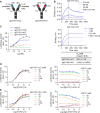A biparatopic agonistic antibody that mimics fibroblast growth factor 21 ligand activity
- PMID: 29483191
- PMCID: PMC5912448
- DOI: 10.1074/jbc.RA118.001752
A biparatopic agonistic antibody that mimics fibroblast growth factor 21 ligand activity
Abstract
Bispecific antibodies have become important formats for therapeutic discovery. They allow for potential synergy by simultaneously engaging two separate targets and enable new functions that are not possible to achieve by using a combination of two monospecific antibodies. Antagonistic antibodies dominate drug discovery today, but only a limited number of agonistic antibodies (i.e. those that activate receptor signaling) have been described. For receptors formed by two components, engaging both of these components simultaneously may be required for agonistic signaling. As such, bispecific antibodies may be particularly useful in activating multicomponent receptor complexes. Here, we describe a biparatopic (i.e. targeting two different epitopes on the same target) format that can activate the endocrine fibroblast growth factor (FGF) 21 receptor (FGFR) complex containing β-Klotho and FGFR1c. This format was constructed by grafting two different antigen-specific VH domains onto the VH and VL positions of an IgG, yielding a tetravalent binder with two potential geometries, a close and a distant, between the two paratopes. Our results revealed that the biparatopic molecule provides activities that are not observed with each paratope alone. Our approach could help address the challenges with heterogeneity inherent in other bispecific formats and could provide the means to adjust intramolecular distances of the antibody domains to drive optimal activity in a bispecific format. In conclusion, this format is versatile, is easy to construct and produce, and opens a new avenue for agonistic antibody discovery and development.
Keywords: antibody engineering; biparatopic antibody; bispecific antibody; drug development; fibroblast growth factor (FGF); fibroblast growth factor receptor (FGFR); single-domain antibody (sdAb, nanobody); β-Klotho.
© 2018 Shi et al.
Conflict of interest statement
All authors are/were employees of Amgen Inc
Figures





References
MeSH terms
Substances
LinkOut - more resources
Full Text Sources
Other Literature Sources
Research Materials
Miscellaneous

